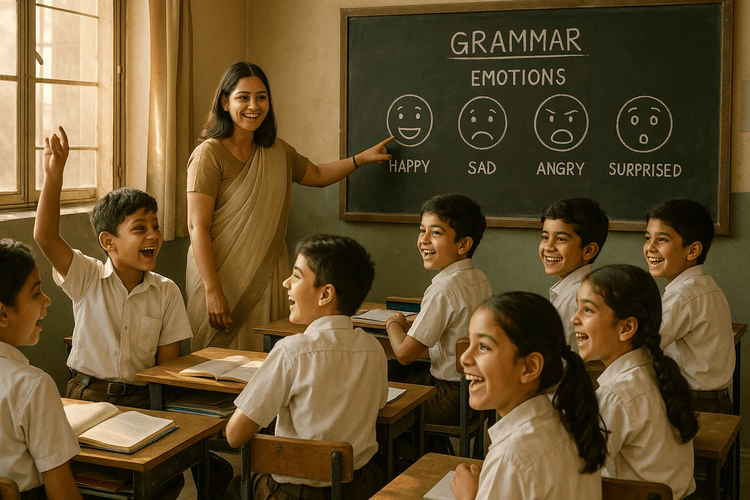Types of Interjections with Examples for Kids | PlanetSpark

Table of Contents
- What Are Interjections?
- Types of Interjections
- Advanced Classification of “Types of Interjections”
- Broad Functions of Interjections
- Why Are Interjections Important?
- How to Teach Interjections to Kids
- Emotional Intensity: Mild vs. Strong Interjections
- Comprehensive Examples List (Alphabetical)
- Placement of Interjections
- Context-Dependent Meaning & Usage
- Common Mistakes to Avoid with Interjections
- PlanetSpark Integration: Making Interjections Real
- Educational Value: Deepening Content Quality
- Summary: Types of Interjections at a Glance
- Conclusion
- FAQs on Types of Interjections
Interjections are powerful tools in the English language. They bring emotion, emphasis, and spontaneity to conversations, making speech more lively and expressive. Whether it's a joyful "Yay!", a sudden "Ouch!", or a curious "Hmm...", interjections help speakers connect more naturally with listeners. Understanding the types of interjections is crucial for anyone looking to master English communication, especially young learners.
PlanetSpark's English Grammar Courses provide a structured yet engaging way for kids to grasp core grammar topics, including interjections. These courses are expertly designed to help students build strong foundational skills in grammar through interactive lessons, live classes, and real-time feedback. Perfect for learners who want to improve their writing, speaking, and comprehension, PlanetSpark’s curriculum covers everything from basic parts of speech to advanced grammar rules, ensuring kids gain the confidence to use English fluently and correctly.
In this blog, we’ll explore the different types of interjections with clear examples to make learning fun and effective. You’ll learn how these short words or phrases can dramatically change the tone of a sentence, and how you can teach them effectively to children.
So, let's dive into the lively world of interjections and discover how they can add color and clarity to your child’s communication skills!
What Are Interjections?
Interjections are words or short phrases used to express a sudden feeling or reaction. They are often found at the beginning of a sentence, though not always, and are typically set apart by punctuation such as an exclamation mark or a comma.
For example:
Wow! That’s a beautiful painting.
Oops! I dropped the glass.
Oh, I didn’t know that.
These expressions do not relate grammatically to the rest of the sentence but are essential in conveying the speaker's emotions or spontaneous reactions.
Types of Interjections
There are several types of interjections based on the emotions or reactions they express. Let’s explore them one by one with examples:
1. Interjections of Joy
These express happiness or delight.
Examples:
Yay! We won the match!
Hurray! It's my birthday.
2. Interjections of Surprise
These show shock or amazement.
Examples:
Wow! That’s an amazing sculpture.
Oh! I didn’t expect to see you here.
3. Interjections of Pain
These express physical or emotional discomfort.
Examples:
Ouch! That really hurt.
Ow! I bumped into the chair.
4. Interjections of Greeting
Used to begin conversations or acknowledge someone.
Examples:
Hello! How are you today?
Hey! Long time no see.
5. Interjections of Approval or Praise
Used to show encouragement or admiration.
Examples:
Bravo! You performed exceptionally well.
Well done! I’m proud of you.
Turn praise into progress! Enroll your child in PlanetSpark’s live grammar sessions and give them the tools to communicate clearly and confidently.
6. Interjections of Sorrow or Grief
Used during sad or upsetting situations.
Examples:
Alas! The hero died in the end.
Oh no! I lost my phone.
7. Interjections of Attention
Used to get someone’s attention.
Examples:
Listen! This is important.
Look! A rainbow!
8. Interjections of Doubt or Hesitation
Express uncertainty or thinking aloud.
Examples:
Hmm... I’m not sure about this answer.
Er... I think I left my bag here.
Want your child to confidently use expressive words like “Wow!” and “Oops”? Try PlanetSpark’s English Grammar Course with a free trial session today.
Advanced Classification of “Types of Interjections”
Various reputable grammar sources classify interjections into categories that provide deeper understanding:
1. Primary Interjections
Unique words that only serve as interjections—they don’t function as nouns, verbs, or adjectives. Examples: Wow!, Ouch!, Yippee!
2. Secondary Interjections
Words that can be used in other ways (like nouns) but serve emotional or reactional functions when used on their own. Examples: Goodness!, Indeed!, Bravo!, Congrats!, Oh dear!
3. Volitive Interjections
Used to issue commands or requests. They function like short directives. Examples: Shh!, Listen!, Stop!, Psst!
4. Emotive Interjections
Express feelings or emotional responses: happiness, anger, disgust, sorrow, and more. Examples: Yay!, Alas!, Ugh!, Yikes!
5. Cognitive Interjections
Express mental reactions like hesitation, realization, or uncertainty. Examples: Hmm…, Aha!, Oh!, Well…, Er…
6. Phatic Interjections
Used for managing social interaction—greetings, farewells, acknowledgments. Examples: Hello!, Bye!, Uh-huh, Yup
Classroom Exercises (Based on ‘Types of Interjections’)
1. Match the Interjection Type
Instructions: Match each interjection with its correct type.
| Interjection | Type |
|---|---|
| Wow! | a) Greeting Interjection |
| Oops! | b) Joy Interjection |
| Hello! | c) Attention Interjection |
| Alas! | d) Sorrow Interjection |
| Hey! | e) Surprise Interjection |
2. Fill in the Blank with a Suitable Interjection
Instructions: Choose the correct interjection to complete each sentence.
______! I just dropped my lunch.
______! We finally won the game.
______! Is anyone there?
______! That was unexpected.
______! I didn’t mean to hurt you.
Suggested Answers:
Oops!
Yay!
Hello!
Whoa!
Sorry!
3. Role Play Using Interjections
Instructions: Pair students and give them a dialogue prompt. Ask them to act it out using at least 5 interjections (joy, surprise, greeting, attention, etc.).
Example Prompt:
Two friends meet at school and one reveals they just got a puppy.
PlanetSpark’s grammar classes help kids understand interjections through fun, interactive examples. Book a free trial class and see the difference!
Broad Functions of Interjections
Interjections serve several core functions in language and communication:
Express emotion instantly (e.g. Yay!, Ouch!)
Draw attention or give commands (e.g. Listen!, Shh!)
Indicate thought processes (e.g. Aha!, Hmm…)
Manage social interaction (e.g. Hello!, Bye!, Uh-huh)
Why Are Interjections Important?
Interjections may be brief, but they serve a huge purpose in daily communication. Here's why they matter:
Express Emotions: They allow the speaker to convey feelings like happiness, surprise, fear, or disappointment quickly.
Make Speech Natural: Native speakers frequently use interjections in both casual and formal conversations.
Improve Writing Quality: In creative writing, interjections help readers understand the character’s emotions and tone.
Engage Listeners: Interjections make dialogues more relatable and less robotic—crucial for public speaking or storytelling.
How to Teach Interjections to Kids
Teaching interjections can be fun if done interactively. Here are some effective methods:
1. Use Everyday Situations
Encourage children to identify and use interjections in their daily life. When they say “Wow!” or “Oops!”, explain what kind of interjection it is.
2. Interactive Grammar Games
Games like “Guess the Emotion” using flashcards with interjections can be engaging and educational.
3. Dramatic Read-Alouds
Have students read stories or dialogues where interjections are used and ask them to act them out with expressions.
4. Writing Exercises
Ask students to write short dialogues or comics and insert suitable interjections to show tone and emotion.
Emotional Intensity: Mild vs. Strong Interjections
Strong interjections convey high emotion and usually end with an exclamation mark:
Wow!, Yay!, Ouch!, Hurrah!, Yikes!
Mild interjections soften the tone and may be followed by commas instead:
Oh, I see, Hmm, that’s interesting, Well, let’s try again
Comprehensive Examples List (Alphabetical)
Here’s a curated list of commonly used interjections across all categories:
Aha, Alas, Ahem, Aw, Bingo, Boo, Bravo, Eek, Eh, Hooray, Hmm, Huh, Oops, Ouch, Phew, Psst, Shh, Ugh, Uh-oh, Yay, Yippee, Yuck, Wow, Wow!, and more.
These activities mirror what PlanetSpark students do in real-time during sessions. Enroll now and experience a free grammar class tailored to your child’s level.
Placement of Interjections
You can position interjections at:
Beginning: Wow! That’s incredible.
Middle (offset by commas): That, oh, was unexpected.
End: That was fun, yay!
Use punctuation consciously to reflect tone.
Context-Dependent Meaning & Usage
Certain interjections change meaning depending on context. For example:
“Oh, I didn’t know that” (mild, neutral)
versus“Oh! I didn’t know that” (strong surprise)
Interjections like “yeah” or “nah” also vary across regions and dialects—common in informal speech.
Common Mistakes to Avoid with Interjections
While interjections are fun, it's important to use them correctly. Watch out for:
Overuse: Using too many interjections can make writing seem immature.
Wrong Tone: Using an interjection of joy in a sorrowful moment can confuse the message.
Punctuation Errors: Always punctuate interjections properly. Use commas or exclamation marks based on tone.
PlanetSpark's expert grammar trainers focus on not just introducing interjections but teaching kids when, how, and where to use them with accuracy and flair.
PlanetSpark Integration: Making Interjections Real
At PlanetSpark, interjections aren’t just taught—they’re experienced:
Role-Play & Skits: Students act out dialogues featuring interjections like “Yikes!” or “Hurray!”
Story Writing Tasks: Children naturally use interjections to express characters’ emotions.
Game-Based Learning: Flashcard games, quizzes, and speech challenges where students guess emotions or craft sentences.
One educator shared:
“Have students create a 2-minute skit using the most interjections possible. Bonus if they include questions to keep it natural.”
These methods align with educational best practices and provide deep, memorable learning.
Educational Value: Deepening Content Quality
Multiple perspectives: We've included emotional, cognitive, polite, and dramatic types of interjections.
Real-life classroom methods: Role-play, examples, and interactivity bring theory to life.
Research-backed categories: The classifications are consistent with academic grammar frameworks.
Summary: Types of Interjections at a Glance
| Type | Function | Sample Interjections |
|---|---|---|
| Primary | Express emotion alone | Wow, Oops, Ouch |
| Secondary | Repurpose existing language elements | Bravo, Goodness, Congrats |
| Volitive | Give commands or requests | Shh, Listen, Stop |
| Emotive | Show sentiment (joy, anger, etc.) | Yay, Ugh, Alas |
| Cognitive | Reveal thought or hesitation | Hmm, Aha, Oh |
| Phatic (Social) | Greetings, acknowledgments | Hello, Bye, Uh-huh |
Conclusion
Interjections may be small, but they carry big emotions and meaning. From expressing happiness and pain to grabbing attention and showing doubt, they enrich communication both in speech and writing. For young learners especially, understanding the types of interjections helps build a strong command of English.
PlanetSpark offers specially curated English Grammar Courses that not only explain grammar rules but also bring them alive through live classes, activities, and expert feedback. Help your child become a confident speaker and writer—one interjection at a time.
FAQs on Types of Interjections
Q1. What are interjections in English grammar?
Interjections are short words or phrases used to express sudden emotions or reactions, often standing apart from the rest of the sentence.
Q2. How many types of interjections are there?
There are 8 main types: joy, surprise, pain, greeting, approval, sorrow, attention, and doubt.
Q3. Can interjections be used in formal writing?
Interjections are more common in informal writing or speech. In formal writing, use them cautiously and only when appropriate.
Q4. Are interjections always followed by an exclamation mark?
Not always. If the tone is mild, a comma can be used. Strong emotions often call for an exclamation mark.
Q5. What’s the difference between an interjection and an exclamation?
An interjection is a part of speech (like “Wow!” or “Oops!”), while an exclamation refers to the sentence type that conveys strong emotion.
Q6. Can children learn interjections easily?
Yes! With fun activities, stories, and interactive grammar classes, children can understand and use interjections naturally.
Q7. How can kids practice interjections at home?
By playing role-playing games, writing expressive stories, or using flashcards to match interjections with emotions.
Personalized Communication Report
Record a video to get a AI generated personalized communication report for your child

Hi There, want to try these
tips for your child with
LIVE with our expert coach?
Let's check your child's
English fluency
